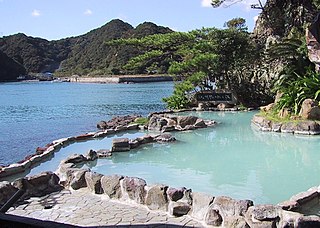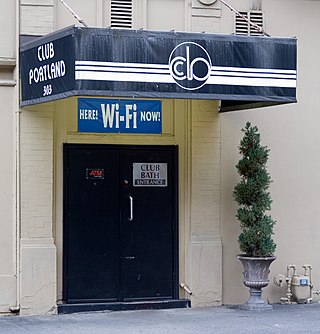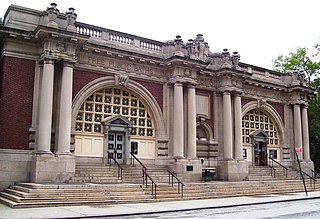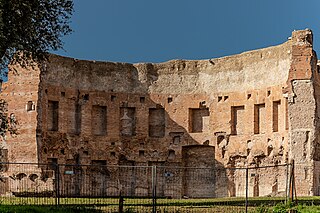
A sauna is a room or building designed as a place to experience dry or wet heat sessions, or an establishment with one or more of these facilities. The steam and high heat make the bathers perspire. A thermometer in a sauna is typically used to measure temperature; a hygrometer can be used to measure levels of humidity or steam. Infrared therapy is often referred to as a type of sauna, but according to the Finnish sauna organizations, infrared is not a sauna.

The Finnish sauna is a substantial part of Finnish and Estonian culture.

A bathroom is a room in which people wash their bodies or parts of their bodies. It can contain one or more of the following plumbing fixtures: a shower, a bathtub, a bidet, and a sink. The inclusion of a toilet is common. There are also specific toilet rooms, only containing a toilet, which in North American English tend to be called "bathrooms", "powder rooms" or "washrooms", as euphemisms to conceal their actual purpose, while they in British and Irish English are known as just "toilets" or possibly "cloakrooms" - but also as "lavatories" when they are public.

In Japan, onsen are hot springs and the bathing facilities and traditional inns around them. There are approximately 25,000 hot spring sources throughout Japan, and approximately 3,000 onsen establishments use naturally hot water from these geothermally heated springs.

Sentō (銭湯) is a type of Japanese communal bathhouse where customers pay for entrance. Traditionally these bathhouses have been quite utilitarian, with a tall barrier separating the sexes within one large room, a minimum of lined-up faucets on both sides, and a single large bath for the already washed bathers to sit in among others. Since the second half of the 20th century, these communal bathhouses have been decreasing in numbers as more and more Japanese residences now have baths. Some Japanese find social importance in going to public baths, out of the theory that physical proximity/intimacy brings emotional intimacy, which is termed skinship in pseudo-English Japanese. Others go to a sentō because they live in a small housing facility without a private bath or to enjoy bathing in a spacious room and to relax in saunas or jet baths that often accompany new or renovated sentōs.

A hammam, called a Moorish bath and a Turkish bath by Westerners, is a type of steam bath or a place of public bathing associated with the Islamic world. It is a prominent feature in the culture of the Muslim world and was inherited from the model of the Roman thermae. Muslim bathhouses or hammams were historically found across the Middle East, North Africa, al-Andalus, Central Asia, the Indian subcontinent, and in Southeastern Europe under Ottoman rule.

In ancient Rome, thermae and balneae were facilities for bathing. Thermae usually refers to the large imperial bath complexes, while balneae were smaller-scale facilities, public or private, that existed in great numbers throughout Rome.

A shower is a place in which a person bathes under a spray of typically warm or hot water. Indoors, there is a drain in the floor. Most showers have temperature, spray pressure and adjustable showerhead nozzle. The simplest showers have a swivelling nozzle aiming down on the user, while more complex showers have a showerhead connected to a hose that has a mounting bracket. This allows the showerer to hold the showerhead by hand to spray the water onto different parts of their body. A shower can be installed in a small shower stall or bathtub with a plastic shower curtain or door. Showering is common due to the efficiency of using it compared with a bathtub. Its use in hygiene is, therefore, common practice.

A gay bathhouse, also known as a gay sauna or a gay steambath, is a public bath targeted towards gay and bisexual men. In gay slang, a bathhouse may be called just "the baths", "the sauna", or "the tubs". Historically, they have been used for sexual activity.

Bathing is the immersion of the body, wholly or partially, in a medium, usually a liquid or heated air. It may be for personal hygiene, religious ritual, or therapeutic purposes. By analogy, especially as a recreational activity, the term is also applied to sun bathing and sea bathing.

Public baths originated when most people in population centers did not have access to private bathing facilities. Though termed "public", they have often been restricted according to gender, religious affiliation, personal membership, and other criteria.

A spa is a location where mineral-rich spring water is used to give medicinal baths. Spa towns or spa resorts typically offer various health treatments, which are also known as balneotherapy. The belief in the curative powers of mineral waters goes back to prehistoric times. Such practices have been popular worldwide, but are especially widespread in Europe and Japan. Day spas and medspas are also quite popular, and offer various personal care treatments.

A steam shower is a type of bathing where a humidifying steam generator produces water vapor that is dispersed around a person's body. A steam shower is essentially a steam room that offers the typical features of a bathroom shower. Steam showers are generally found in self-contained enclosures that prevent the water vapour from escaping into the rest of the room, avoiding damage to drywall, paint, or wallpaper. Steam showers combine the functionality of a standard steam room with many additional features including a shower, FM radio and hydrotherapy. Steam showers are available in a variety of materials, including tile, acrylic, fiberglass, glass, stone, and wood.

The banya is a traditional Russian steam bath that utilizes a wood stove. It is a significant part of Russian culture, and is typically conducted in a small room or building designed for dry or wet heat sessions. The high heat and steam cause bathers to perspire.

Bathing played a major part in ancient Roman culture and society. It was one of the most common daily activities and was practised across a wide variety of social classes. Though many contemporary cultures see bathing as a very private activity conducted in the home, bathing in Rome was a communal activity. While the extremely wealthy could afford bathing facilities in their homes, private baths were very uncommon, and most people bathed in the communal baths (thermae). In some ways, these resembled modern-day destination spas as there were facilities for a variety of activities from exercising to sunbathing to swimming and massage.

A steam bath is a steam-filled room for the purpose of relaxation and cleansing. It has a long history, going back to Greek and Roman times.

Bathhouse Row is a collection of bathhouses, associated buildings, and gardens located at Hot Springs National Park in the city of Hot Springs, Arkansas. The bathhouses were included in 1832 when the Federal Government took over four parcels of land to preserve 47 natural hot springs, their mineral waters which lack the sulphur odor of most hot springs, and their area of origin on the lower slopes of Hot Springs Mountain.
Finnila's Finnish Baths—a.k.a. Finnila's—was a Finnish bathhouse and a health club in San Francisco, California. It served the general public from circa 1910 to September, 2000. Finnila's was located in the Castro District of San Francisco for its first 75 years.

Greek baths were bath complexes suitable for bathing and cleaning in ancient Greece, similar in concept to that of the Roman baths. Greek baths are a feature of some Hellenized countries. These baths have been found in Greece, Egypt, Italy, and there is even one located in Marseille, France. Some of the first baths have been dated back to the 5th century BCE. The public baths had a gradual development into the flourishing, culturally-significant structures of the Hellenistic age. The multiple locations of the baths throughout the Mediterranean offer different, culturally-unique developments.
Chinese bathhouses have thousands of years of history and consist of numerous variations. The Chinese word for bathhouses in general is zǎotáng (澡堂); although in the stricter sense may refer to traditional, low-cost Chinese bathhouses to contrast with modern, upmarket Chinese bathhouses known as xǐyù zhōngxīn (洗浴中心) or just xǐyù (洗浴). Hot springs and spas are called wēnquán (温泉).

















